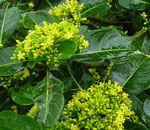|
Psycotria capensis
Black
bird-berry, swartvoelbessie, iZele Article by Geoff Nichols
Psychotria
belongs
to the coffee family and is a large
shrub of two to three metres in height to a smallish tree of four to
five metres that is found in the forests and bush clumps of the eastern
parts of this country. The leaves are fairly large about 100mm long and
have a rounded look
to them. The midribs tend to be paler than the leaves. The leaves are
shiny
and have a bright sort of look. Hope this makes sense to you. What I'm
trying
to say is this plant has a fresh feel to it and never seems to dull the
imagination.
It is a
very adaptable plant growing in many varying conditions from
deep shade to full sun in very exposed places like on cliff edges in
the teeth of the wind and vulnerable to the teeth of dassies.
They
produce, in spring, small yellow flowers in clusters at the ends
of the branches giving the plants a bright yellow appearance.
Then
in the late summer the fruits begin to ripen changing from a green
through
yellow to red when fully ripe. This is where I come back to my point of
sitting at my window.
|

Click on
Image
|
The birds that come
to these berries are many and
varied. However the speckled mousebirds are my favourites with their
clambering ways the bush
comes alive with the mouse-like antics of these birds picking off fruit
to
eat. Other birds that I've noticed at my bird-berry are blackcollared
barbets,
blackeyed and sombre bulbuls, blackbellied and redwinged starlings,
purplecrested
louries and Cape white-eyes. In fact the most common plant that
germinates
in my garden from the seed that birds drop is Psychotria capensis.

Photo
Geoff Nichols
|
There
are many uses for this
plant as a specimen plant, hedge, shrubbery subject and as an indoor
plant.
The last use is one is a good use as the young stems remain green and
are
attractive with their upright growth and opposite branching habit they
make
a very neat and well balanced plant in a pot/container. This is where
my
point of the bright green leaves comes into play, they simply always
brighten
up a dull office. Like many of the coffee family the leaves contain a
cyanide
based compound that make them unpalatable to insects. But tell this to
the
vervet monkeys in Burman Bush they still carry
on
eating off all the young leaves leaving us with green stalks to admire.
|
|
